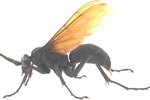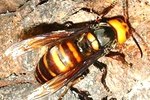Things You'll Need
Healthy vision and/or magnifying glass
Tweezers (if the insect is deceased)
Warnings
Do not try to investigate a wasp while it is still alive. Some of the differences are visible, and others are more detailed and harder to see with the naked eye. To prevent stings, especially if you have allergies, be sure not to upset the wasps when observing their lifestyles. If you do get stung, place ice on the wound and take an antihistamine. If the wound does not get better, see a doctor.
Tips
When trying to observe wasps, try not to do so from August through October because they tend to be more aggressive during those months. Also, wasps are inactive at night, so that could be a good time to observe their nests or living area. Keep in mind that wasps have a high sensitivity for light. As always, be careful when dealing with any insect or animal that could potentially hurt you.
Wasps often eat ferment from plants and have been known to become intoxicated and pass out. Whether you are interested in learning more such facts about these insects that share your backyard, or are just concerned about preventing stings and allergies, it is important to know the difference between the male and female wasp as only one gender really causes a concern.
The Differences Between Male and Female Wasps
Consider all safety precautions before observing the differences between male and female wasps. Buy proper equipment or protective gear. Also, there are ways to tell the difference with just the naked eye, but if you want to study the insects in depth, and they are no longer alive, a magnifying glass will help you see the wasp more clearly, and the tweezers will allow you to move the wasp around. Be careful of the stinger. Dead insects are usually brittle, so treat the body gently.
Observe the insect's size. Size is the most obvious difference between the male and female wasps. Females are larger than the males because they carry the eggs. Due to this extra baggage, their abdomen is usually fatter and fuller.
Notice if it has a stinger. Female wasps are the more dangerous of the two because they are the gender that carries the stinger, called an ovipositor. Unlike the honey bee, the stinger of the female wasp is not barbed, meaning it can repeatedly sting and give a predator or threat its venom.The stinger of the female wasp is also its sex organ. Male wasps do not sting, but they sometimes act as though they will by instinct.
Observe the distance between the wasp and the nest. Due to the fact that the female wasps are born with the stinger, they have the best weapon against any threat, so they remain closer to the nest. Although this is not the most foolproof way to determine the sex of a wasp, it is important to still pay attention to the behavior of the wasp because it gives clues to its gender.
Count the antennae segments. It is another difference between male and female wasps. In the male, you can find thirteen segments on their antennae. In the female, there are only twelve. This is one difference that is not technically noticeable unless you have those tweezers and magnifying glass in hand.
References
Resources
Tips
- When trying to observe wasps, try not to do so from August through October because they tend to be more aggressive during those months. Also, wasps are inactive at night, so that could be a good time to observe their nests or living area. Keep in mind that wasps have a high sensitivity for light. As always, be careful when dealing with any insect or animal that could potentially hurt you.
Warnings
- Do not try to investigate a wasp while it is still alive. Some of the differences are visible, and others are more detailed and harder to see with the naked eye. To prevent stings, especially if you have allergies, be sure not to upset the wasps when observing their lifestyles. If you do get stung, place ice on the wound and take an antihistamine. If the wound does not get better, see a doctor.
Photo Credits
-
wasp image by Henryk Olszewski from Fotolia.com





